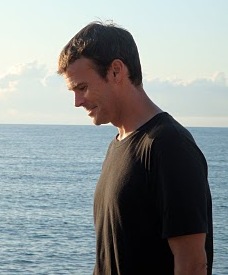The trains to and from Arashiyama were packed with tourists out to see the autumn leaves on Sunday, but Mewby and I together with the volunteers of P.T.O. escaped from the crowds and up to the summit of Ogurayama where we were blessed with some spectacular views.

I have more pictures on flickr here, and Lucinda Cowling has written up a very nice summary of our day here (so I shan’t bother) but there are so many spots to view the autumn foliage in Kyoto… and as Stewart Wachs wrote earlier this week they are “sometimes so beautiful it can make you cry”. I asked Stewart and some other friends of Deep Kyoto:
What is your favorite location for viewing autumn foliage in Kyoto?
 Stewart Wachs is from the U.S.A. He is a professor of British and American Studies at Kyoto University of Foreign Studies, a photographer, a writer and an associate editor of Kyoto Journal. Stewart says,
Stewart Wachs is from the U.S.A. He is a professor of British and American Studies at Kyoto University of Foreign Studies, a photographer, a writer and an associate editor of Kyoto Journal. Stewart says,
The woods in the precincts of Kamigamo Shrine. I once lived just down the road from here, in a small tatami flat behind a big pickling vegetable patch, and the shrine forest was our neighborhood’s magical sanctuary. A brook runs through these woods and in summer fireflies meander through the dense darkness above its current. Here and there certain boulders are encircled with rope, marking them as sacred, and some are topped with small Shinto altars like the one in this photo. The maple trees are wild, or feel so; they aren’t overly designed or arrayed, yet the range of autumnal hues glowing from shafts of light always delights my eyes…
And Stewart (being a photographer) has also sent us this lovely picture to enjoy.

 Roger Walch is from Switzerland. He is a film-maker, photographer, jazz pianist, interpreter, and guide. You can read about his movie Children of Water here. Roger says,
Roger Walch is from Switzerland. He is a film-maker, photographer, jazz pianist, interpreter, and guide. You can read about his movie Children of Water here. Roger says,
Chikurinji (竹林寺) Temple in Kamikitano, not far from Yase station (Eizan Dentetsu). A temple off the beaten track, a jewel of a garden with beautiful maple and ginkgo trees, a pond with the clearest water you can imagine, mirroring the spectacular autumn foliage…
And Roger (being a film-maker) has also sent us a lovely video of Chikurinji which you can view at the end of this post.
 John Dougill is from the UK. He is professor of British Studies at Kyoto’s Ryukoku University and the author of Kyoto: A Cultural History
John Dougill is from the UK. He is professor of British Studies at Kyoto’s Ryukoku University and the author of Kyoto: A Cultural History (read review here). John says,
My favourite place for ‘momijigari’ (maple viewing) ji is as far away from Tofukuji as i can reasonably get. I prefer to look at leaves rather than the heads of people pushing elbows into me! One attractive place on the north-west fringes of Kyoto is Takao, where there are cultural items of interest to leaven the leaf-gazing. It’s far enough out of the city to feel that one is entering another time frame. The maples can best be seen around Jingo-ji, where after climbing the steep steps you can throw a clay disc into the valley below in the hopes of having your wish granted. Autumn foliage plus your dream come true: it’s certainly value for money! After that bit of exercise it’s nice to relax at Kozan-ji, a World Heritage site which claims to be the site of the first tea cultivation in Japan. It also houses the world’s first manga, the wonderful thirteenth-century Chojugiga (the original is in Tokyo but you can see a copy.) The surrounding woods provide opportunities for deep lungfuls of life-enhancing air, and you can sit and drink a calming bowl of green tea while feasting your eyes on some spectacular maple-dappled views. Those of an energetic nature then have the option of taking a pleasant stroll along the Kiyotaki river, though the surrounds there are mainly cedar. Personally I prefer to revel in the colours and have a second bowl of tea! (Takao can be reached by the JR bus bound for Yamashiro-Takao and ToganÅ stations or by Kyoto city bus #8. Cost is about \500 each way.)
 Keiji Minato was born in the south of Osaka Prefecture, Japan in 1973 and has been living in Kyoto for more than fifteen years. A poet and translator he writes haiku, senryu, and free verse and published a book of poetry, Garasu no me / Nuno no hifu
Keiji Minato was born in the south of Osaka Prefecture, Japan in 1973 and has been living in Kyoto for more than fifteen years. A poet and translator he writes haiku, senryu, and free verse and published a book of poetry, Garasu no me / Nuno no hifu [Glass Eyes / Cloth Skin], in 2004. Once a month he also writes a poetry column on Deep Kyoto. You can read his poetry on his website here. Keiji says,
As a famous place of autumn leaves, I recommend Shisendo (è©©ä»™å ‚), which means “The Temple of the Poet-Recluse.” Though it is a small temple, the gardens are tended really well. Superb, usually quiet place. Unfortunately, it might be too crowded in this season, as all the other
famous spots are… Personally, I like momiji by the front approach to Ryoanji (é¾å®‰å¯º). I used to live near the temple, and walked countless times under their leaves, green and red.
 Mitsu Salmon is from the U.S. She is a teacher, dancer, performer and organizer of International Love Cabaret. Mitsu says,
Mitsu Salmon is from the U.S. She is a teacher, dancer, performer and organizer of International Love Cabaret. Mitsu says,
One of my favorite temples in Kyoto is Kodaiji. It is in the Higashiyama Mountains a little south of Yasaka Shrine. They have a light up in the fall, which means you can sit there at sunset. There are very few people at that time and it is very serene. However last year the light up was pretty over the top, flashing neon squares in the rock garden. So I suggest leaving before that gets started.
On the larger scale, Kiyomizu’s red leaves and view of the hills is absolutely breath taking. In the evening for the light-up, the place feels bewitched.
 Ted Taylor is from the U.S.A. He is a yoga teacher and the writer of the blogs Notes from the ‘Nog and Dueling Bentos. He has also published online the only English guide to the Kansai section of the TÅkai Shizen HodÅ. Ted says,
Ted Taylor is from the U.S.A. He is a yoga teacher and the writer of the blogs Notes from the ‘Nog and Dueling Bentos. He has also published online the only English guide to the Kansai section of the TÅkai Shizen HodÅ. Ted says,
I don’t know if I have a favorite place per se, as Kyoto has so many beautiful places in which to enjoy them. Yet I still carry the memory of my first autumn in Japan, visiting Kyoto on a long November weekend. I remember walking out of Kinkaku-ji, along well-sculpted stones damp with the rain of a brief storm. I’ll never forget the sight of the colorful leaves, blown prematurely from their 8 month perch, now sticking to the stones like so many pressed flowers.
 Felicity Greenland is from the U.K. She is a teacher, musician and singer of traditional British and Irish music. Felicity says,
Felicity Greenland is from the U.K. She is a teacher, musician and singer of traditional British and Irish music. Felicity says,
In Liverpool our school route was through streets of Victorian houses and in autumn their pavements were feet thick with giant plane and chestnut leaves. There was none of the daily sweeping that we have in Kyoto and we used to slide our feet under the leaves, shunting along until we were up to our necks in brown and yellow. I can still remember the rustling, the damp weight and the slight fear of finding one of God’s creatures on (or in) my coat. So, in the Kyoto leaf-viewing season I used to get a bit autumn schmautumn. I secretly wished they would leave them on the streets where they could be fully enjoyed. But then, I happened to cycle, one November, the wooded lane from Ginkakuji to Honen-in and on, and on, southward. All along there were colours I never imagined leaves could be. This is the path I recommend to non-believers.
Many thanks to all the contributors!